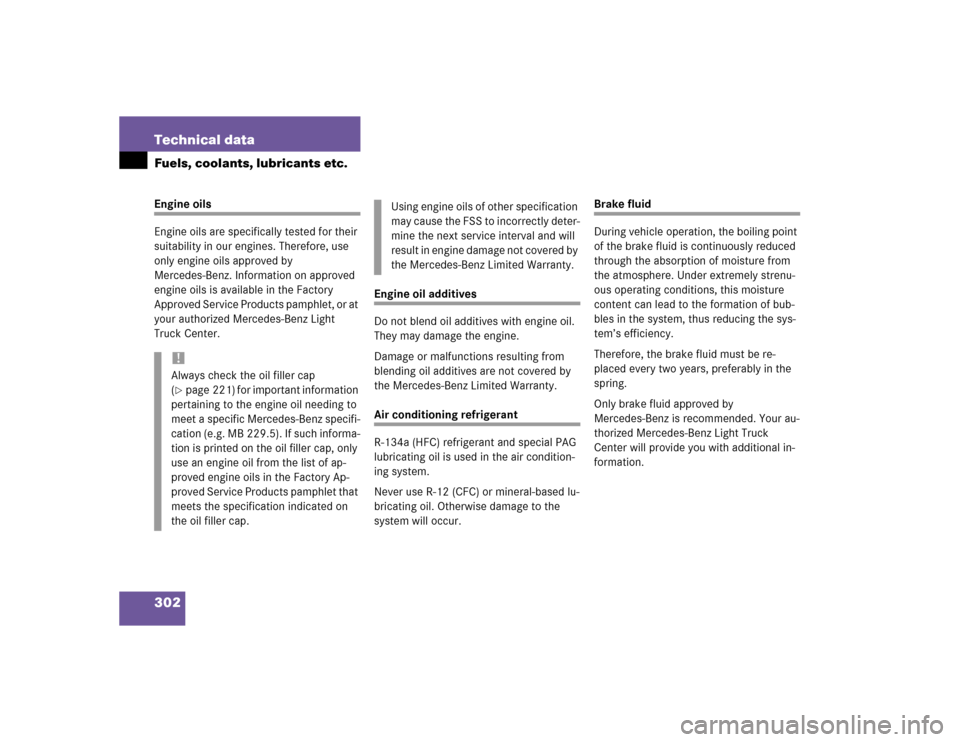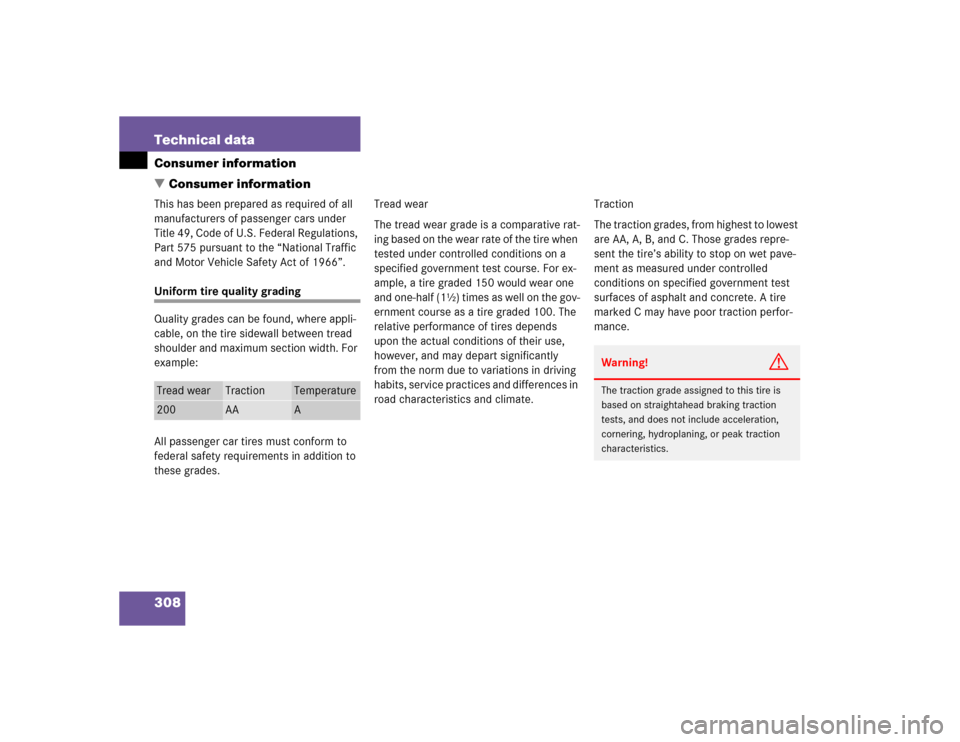Page 289 of 344
289 Technical data
Spare parts service
Warranty coverage
Identification labels
Layout of poly-V-belt drive
Engine
Rims and tires
Electrical system
Main Dimensions
Weights
Fuels, coolants, lubricants etc.
Consumer information
Page 290 of 344
290 Technical dataSpare parts service
�The “Technical data” section provides the
necessary technical data for your vehicle.
Spare parts service
All authorized Mercedes-Benz Centers
maintain a stock of genuine
Mercedes-Benz Parts parts required for
maintenance and repair work. In addition,
strategically located parts distribution cen-
ters provide quick and reliable parts ser-
vice.
More than 300 000 different spare parts
for Mercedes-Benz models are available.
Genuine Mercedes-Benz spare parts are
subjected to stringent quality inspections.
Each part has been specifically developed,
manufactured or selected for and adapted
to Mercedes-Benz vehicles.
Therefore, genuine Mercedes-Benz spare
parts should be installed.
!The use of non-genuine Mercedes-Benz
parts and accessories not authorized
by Mercedes-Benz could damage the
vehicle, which is not covered by the
Mercedes-Benz Limited Warranty, or
could compromise the vehicle’s dura-
bility or safety.
Page 291 of 344
291 Technical data
Warranty coverage
�Warranty coverage
Your vehicle is covered under the terms of
the “warranties” printed in the Service and
Warranty Information booklet. Your
authorized Mercedes-Benz Light Truck
Center will exchange or repair any defec-
tive parts originally installed on the vehicle
in accordance with the terms of the follow-
ing warranties:�
New Vehicle Limited Warranty
�
Emission System Warranty
�
Emission Performance Warranty
�
California, Maine, Massachusetts, and
Vermont Emission Control Systems
WarrantyReplacement parts and accessories are
covered by the Mercedes-Benz Spare Parts
and Accessories warranties, copies of
which are available at any Mercedes-Benz
Center.
Loss of Service and Warranty
Information Booklet
Should you lose your Service and Warranty
Information booklet, have your authorized
Mercedes-Benz Center arrange for a
replacement. It will be mailed to you.
Page 300 of 344
300 Technical dataFuels, coolants, lubricants etc.
�Fuels, coolants, lubricants etc.Capacities
Vehicle components and their respective
lubricants must match.Therefore use only brands tested and
approved by Mercedes-Benz.Please refer to the Factory Approved
Service Products pamphlet, or inquire at
your Mercedes-Benz Light Truck Center.
Model
Capacity
Fuels, coolants, lubricants etc.
Engine with oil filter
ML 350, ML 500
8.5 US qt (8.0 l)
Approved engine oils
Automatic transmis-
sion
9.0 US qt (8.5 l)
MB Automatic Transmission Oil
Transfer case
1.6 US qt (1.5 l)
(Dexron 3 or Dexron 2E)
Rear axle
1.3 US qt (1.25 l)
(Hypoid gear oil SAE 90, 85 W 90)
Front axle
1.2 US qt (1.1 l)
(Hypoid gear oil SAE 90)
Power steering
approx. 0.65 US qt (0.6 l)
MB Power Steering Fluid
Front wheel hubs
approx. 1.5oz (43g) each
High temperature roller bearing grease
Page 302 of 344

302 Technical dataFuels, coolants, lubricants etc.Engine oils
Engine oils are specifically tested for their
suitability in our engines. Therefore, use
only engine oils approved by
Mercedes-Benz. Information on approved
engine oils is available in the Factory
Approved Service Products pamphlet, or at
your authorized Mercedes-Benz Light
Truck Center.
Engine oil additives
Do not blend oil additives with engine oil.
They may damage the engine.
Damage or malfunctions resulting from
blending oil additives are not covered by
the Mercedes-Benz Limited Warranty.Air conditioning refrigerant
R-134a (HFC) refrigerant and special PAG
lubricating oil is used in the air condition-
ing system.
Never use R-12 (CFC) or mineral-based lu-
bricating oil. Otherwise damage to the
system will occur.
Brake fluid
During vehicle operation, the boiling point
of the brake fluid is continuously reduced
through the absorption of moisture from
the atmosphere. Under extremely strenu-
ous operating conditions, this moisture
content can lead to the formation of bub-
bles in the system, thus reducing the sys-
tem’s efficiency.
Therefore, the brake fluid must be re-
placed every two years, preferably in the
spring.
Only brake fluid approved by
Mercedes-Benz is recommended. Your au-
thorized Mercedes-Benz Light Truck
Center will provide you with additional in-
formation.
!Always check the oil filler cap
(�page 221) for important information
pertaining to the engine oil needing to
meet a specific Mercedes-Benz specifi-
cation (e.g. MB 229.5). If such informa-
tion is printed on the oil filler cap, only
use an engine oil from the list of ap-
proved engine oils in the Factory Ap-
proved Service Products pamphlet that
meets the specification indicated on
the oil filler cap.
Using engine oils of other specification
may cause the FSS to incorrectly deter-
mine the next service interval and will
result in engine damage not covered by
the Mercedes-Benz Limited Warranty.
Page 304 of 344

304 Technical dataFuels, coolants, lubricants etc.Damage or malfunctions resulting from
poor fuel quality or from blending specific
fuel additives are not covered by the
Mercedes-Benz Limited Warranty.Coolants
The engine coolant is a mixture of water
and anticorrosion / antifreeze, which pro-
vides:�
Corrosion protection
�
Freeze protection
�
Boiling protection (by increasing the
boiling point)
The cooling system was filled at the factory
with a coolant providing freeze protection
to approximately -35°F (-37°C) and corro-
sion protection.
If the antifreeze mixture is effective to
-22°F (-30°C), the boiling point of the cool-
ant in the pressurized cooling system is
reached at approximately 266°F (130°C).The coolant solution must be used year
round to provide the necessary corrosion
protection and increase in boil-over pro-
tection. Refer to Service Booklet for
replacement interval.
To provide important corrosion protection,
the solution must be at least 45%
anticorrosion / antifreeze (equivalent to
freeze protection to approx. - 22°F
[-30°C]). If you use a solution that is more
than 55% anticorrosion / antifreeze (freeze
protection to approx. - 49°F [-45°C]), the
engine temperature will increase due to
the lower heat transfer capability of the so-
lution. Therefore, do not use more than
this amount of anticorrosion / antifreeze.If the coolant level is low, water and MB
anticorrosion / antifreeze should be used
to bring it up to the proper level (have cool-
ing system checked for signs of leakage).
Please make sure the mixture is in accor-
dance with label instructions.
The water in the cooling system must meet
minimum requirements, which are usually
satisfied by normal drinking water. If you
are not sure about the water quality, con-
sult your authorized Mercedes-Benz Light
Truck Center.
Page 305 of 344
305 Technical data
Fuels, coolants, lubricants etc.
Anticorrosion / antifreeze
Your vehicle contains a number of alumi-
num parts. The use of aluminum compo-
nents in motor vehicle engines
necessitates that
anticorrosion / antifreeze coolant used in
such engines be specifically formulated to
protect the aluminum parts. (Failure to use
such anticorrosion / antifreeze coolant will
result in a significantly shortened service
life.)
Therefore, the following product is strongly
recommended for use in your vehicle:
Mercedes-Benz Anticorrosion / Antifreeze
agent.
Before the start of the winter season (or
once a year in hot southern regions), you
should have the anticorrosion / antifreeze
concentration checked. The coolant is also
regularly checked each time you bring your
vehicle to your authorized Mercedes-Benz
Light Truck Center for service.
Page 308 of 344

308 Technical dataConsumer information
�Consumer informationThis has been prepared as required of all
manufacturers of passenger cars under
Title 49, Code of U.S. Federal Regulations,
Part 575 pursuant to the “National Traffic
and Motor Vehicle Safety Act of 1966”.Uniform tire quality grading
Quality grades can be found, where appli-
cable, on the tire sidewall between tread
shoulder and maximum section width. For
example:
All passenger car tires must conform to
federal safety requirements in addition to
these grades.Tread wear
The tread wear grade is a comparative rat-
ing based on the wear rate of the tire when
tested under controlled conditions on a
specified government test course. For ex-
ample, a tire graded 150 would wear one
and one-half (1½) times as well on the gov-
ernment course as a tire graded 100. The
relative performance of tires depends
upon the actual conditions of their use,
however, and may depart significantly
from the norm due to variations in driving
habits, service practices and differences in
road characteristics and climate.Traction
The traction grades, from highest to lowest
are AA, A, B, and C. Those grades repre-
sent the tire’s ability to stop on wet pave-
ment as measured under controlled
conditions on specified government test
surfaces of asphalt and concrete. A tire
marked C may have poor traction perfor-
mance.Tread wear
Traction
Temperature
200
AA
A
Warning!
G
The traction grade assigned to this tire is
based on straightahead braking traction
tests, and does not include acceleration,
cornering, hydroplaning, or peak traction
characteristics.